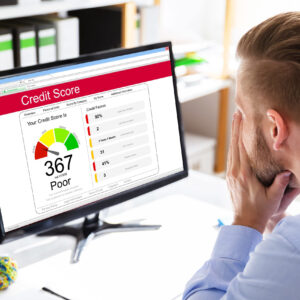This study guide is crafted to assist you in preparing thoroughly for your PHY121 exam by offering an extensive collection of past questions along with detailed answers. Whether you’re reviewing essential concepts or honing your problem-solving abilities, this guide will deepen your understanding and increase your confidence.
Phy121 past questions and answers 1
Question: The number of protons in an atom determines which property?
Options:
(a) Physical
(b) Chemical
(c) Electrical
(d) Magnetic
Correct Answer: (b) Chemical
Explanation: The number of protons in an atom’s nucleus, also known as the atomic number, determines the element’s identity and its chemical properties. This is because the number of protons defines the element and influences how it interacts with other elements during chemical reactions.
Phy121 past questions and answers 2
Question: In the photoelectric effect,
Options:
(a) Electrons are emitted from the metal surface
(b) Product of wavelength and frequency
(c) Ratio of frequency and wavelength
(d) None
Correct Answer: (a) Electrons are emitted from the metal surface
Explanation: The photoelectric effect occurs when light of sufficient energy strikes the surface of a metal, causing the emission of electrons. This phenomenon demonstrates the particle nature of light, where photons transfer their energy to electrons, enabling them to escape the metal surface.
Phy121 past questions and answers 3
Question: The speed of a wave “v” is given by
Options:
(a) Ratio of wavelength and frequency
(b) Product of wavelength and frequency
(c) Ratio of frequency and wavelength
(d) Conductor
Correct Answer: (b) Product of wavelength and frequency
Explanation: The speed of a wave v is calculated using the equation v=λf, where λ\lambdaλ is the wavelength and f is the frequency of the wave. This relationship shows that the speed of a wave is the product of its wavelength and frequency.
Phy121 past questions and answers 4
Question: ________ is the characteristic of a conductor that determines how much current is obtained.
Options:
(a) Resistance
(b) Resistor
(c) Resistivity
(d) Conductor
Correct Answer: (a) Resistance
Explanation: Resistance is a property of a material that opposes the flow of electric current. The higher the resistance, the lower the current for a given voltage, as per Ohm’s law I=V/R
Phy121 past questions and answers 5
Question: From P=QVBsinθ, the force is maximum when θ is
Options:
(a) 90°
(b) 0°
(c) 60°
(d) 45°
Correct Answer: (a) 90°
Explanation: The equation P=QVBsinθ describes the force on a charged particle moving through a magnetic field. The force is maximum when θ, the angle between the velocity vector and the magnetic field, is 90°, because sin90°=1.
Phy121 past questions and answers 6
Question: Four resistors 2Ω, 3Ω, 4Ω, and 6Ω are connected in parallel to a voltage source of 60V. What current will flow through the 4Ω resistor?
Options:
(a) 15A
(b) 30A
(c) 10A
(d) 20A
Correct Answer: (c) 10A
Explanation: For resistors in parallel, the voltage across each resistor is the same. The current through the 4Ω resistor can be calculated using Ohm’s law:
I=V/R=60V/4Ω=15A
Phy121 past questions and answers 7
Question: The unit of electric field strength is
Options:
(a) N/C
(b) C
(c) N
(d) F
Correct Answer: (a) N/C
Explanation: The electric field strength is defined as the force per unit charge, measured in newtons per coulomb (N/C).
Phy111 past questions and answers 8
Question: Coulomb’s law and gravitational law are both
Options:
(a) Inverse square law
(b) Repulsive law
(c) Square root law
(d) Power law
Correct Answer: (a) Inverse square law
Explanation: Both Coulomb’s law and Newton’s law of universal gravitation describe forces that decrease in magnitude with the square of the distance between two objects. This relationship is known as the inverse square law.
Phy121 past questions and answers 9
Question: Electric lines of force originate from the ______
Options:
(a) Positive charge
(b) Negative charge
(c) North charge
(d) None of the above
Correct Answer: (a) Positive charge
Explanation: Electric field lines, or lines of force, originate from positive charges and terminate at negative charges. They indicate the direction a positive test charge would move in the presence of the field.
Phy121 past questions and answers 10
Question: When a glass rod is rubbed with silk, the charge on the glass rod is
Options:
(a) Positive
(b) Negative
(c) Current
(d) Electrostatic
Correct Answer: (a) Positive
Explanation: When a glass rod is rubbed with silk, electrons are transferred from the glass to the silk, leaving the glass rod with a positive charge.
Phy121 past questions and answers 11
Question: When current passes through two parallel conductors placed in a magnetic field in the same direction, _________ force acts on the conductors.
Options:
(a) Gravitational
(b) Electrical
(c) Frictional
(d) Constant
Correct Answer: (d) Constant
Explanation: When two parallel conductors carrying current in the same direction are placed in a magnetic field, they experience an attractive force due to the magnetic fields generated by the currents. This force is constant as long as the current remains steady.
Phy121 past questions and answers 12
Question: From Faraday’s law of electromagnetic induction, _______ magnetic field does not induce current in a closed loop.
Options:
(a) Changing
(b) Same
(c) Different
(d) None
Correct Answer: (b) Same
Explanation: According to Faraday’s law, only a changing magnetic field induces an electromotive force (EMF) and thus a current in a closed loop. A constant magnetic field will not induce a current.
Phy121 past questions and answers 13
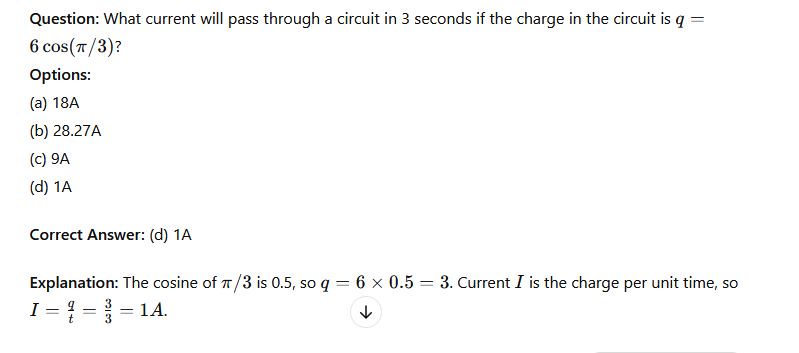
Phy121 past questions and answers 14
Question: The distance from the principal focus to the pole of a mirror measured along the principal axis is known as
Options:
(a) Principal axis
(b) Centre of curvature
(c) Focal length
(d) Focal point
Correct Answer: (c) Focal length
Explanation: The focal length is the distance between the mirror’s pole and its principal focus, measured along the principal axis.
Phy121 past questions and answers 15
Question: What is the nature of the image produced by a diverging mirror irrespective of the position of the object from the mirror?
Options:
(a) Real, inverted, and magnified
(b) Virtual, inverted, and magnified
(c) Virtual, erect, and diminished
(d) Virtual, erect, and magnified
Correct Answer: (c) Virtual, erect, and diminished
Explanation: A diverging mirror, such as a convex mirror, always produces an image that is virtual (cannot be projected on a screen), erect, and smaller than the object, regardless of the object’s position.
Phy121 past questions and answers 16
Question: When a mirror rotates through an angle, the reflected beam rotates _______ that angle.
Options:
(a) 90°
(b) Once
(c) Twice
(d) 180°
Correct Answer: (c) Twice
Explanation: When a mirror rotates by an angle θ, the reflected beam rotates by twice that angle, i.e., 2θ
Phy121 past questions and answers 17
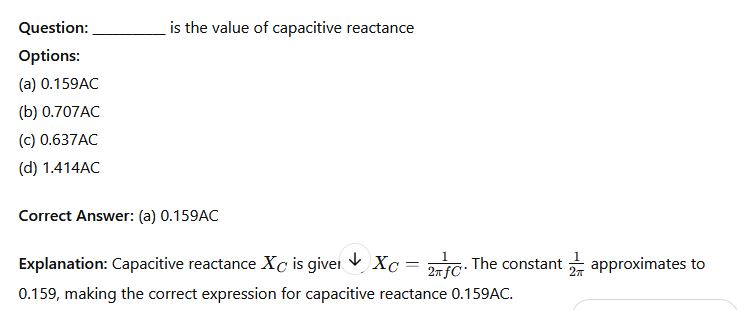
Phy121 past questions and answers 18
Question: For an atom to be electrically neutral, the number of electrons and protons must be _______
Options:
(a) Equal
(b) Zero
(c) Estimated
(d) Varied
Correct Answer: (a) Equal
Explanation: For an atom to be electrically neutral, it must have an equal number of protons (positive charge) and electrons (negative charge), so their charges cancel each other out.
Phy121 past questions and answers 19
Question: The AC and DC uses
Options:
(a) Slip and split ring
(b) Rings
(c) Split and slip ring
(d) Slip ring
Correct Answer: (a) Slip and split ring
Explanation: AC (alternating current) uses slip rings, while DC (direct current) uses split rings. Slip rings maintain a continuous connection, allowing the current to alternate,
while split rings reverse the current’s direction.
Phy121 past questions and answers 20
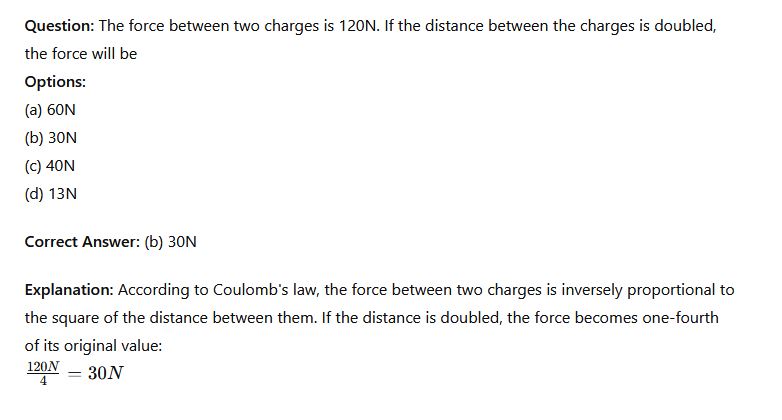
Phy121 past questions and answers 21
Question: The ability of charged bodies to exert force on one another is attributed to the existence of
Options:
(a) Electrons
(b) Protons
(c) Neutrons
(d) Electric field
Correct Answer: (d) Electric field
Explanation: Charged bodies exert force on each other through the electric field they generate. The electric field mediates the force of attraction or repulsion between charges.
Phy121 past questions and answers 22
Question: The line of force due to charged particles are ______
Options:
(a) Straight
(b) Curved
(c) Irregular
(d) None
Correct Answer: (b) Curved
Explanation: The electric field lines due to charged particles are generally curved, especially when multiple charges interact, causing the lines to bend.
Phy121 past questions and answers 23
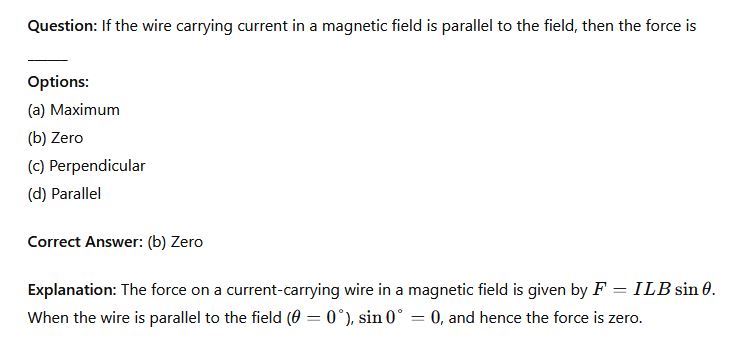
Phy121 past questions and answers 24
Question: Isotopes are atoms whose nuclei have the same proton number but different _______ numbers.
Options:
(a) Electrons
(b) Neutrons
(c) Electron properties
(d) Nuclear force
Correct Answer: (b) Neutrons
Explanation: Isotopes are variants of an element that have the same number of protons (same atomic number) but different numbers of neutrons, resulting in different atomic masses.
Phy121 past questions and answers 25
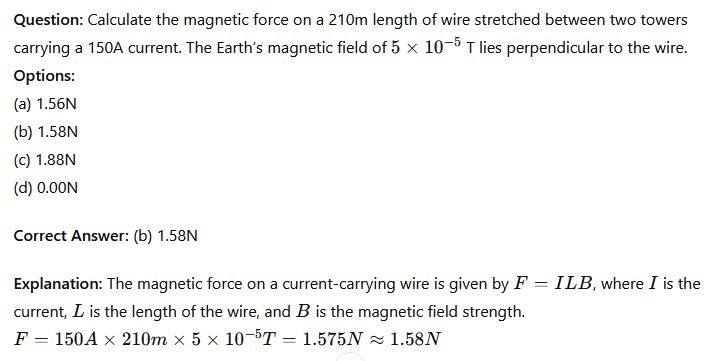
Phy121 past questions and answers 27
Question: One of these is a simple application of Gauss’ law
Options:
(a) Electric field in the presence of a magnet
(b) Electric field due to a charged spherical conductor
(c) Magnetic field due to a charged cylinder
(d) Magnetic field in the presence of a current-carrying wire
Correct Answer: (b) Electric field due to a charged spherical conductor
Explanation: Gauss’ law is commonly applied to calculate the electric field around symmetric charge distributions, such as a charged spherical conductor.
Phy121 past questions and answers 28
Question: Any two equal but opposite charges separated by a distance 2d is
Options:
(a) Electric dipole moment
(b) Electric dipole
(c) Equipotential
(d) Potential
Correct Answer: (b) Electric dipole
Explanation: An electric dipole consists of two equal and opposite charges separated by a certain distance. The dipole moment is the product of the charge and the separation distance.
Phy121 past questions and answers 29
Question: The potential difference between the terminals of a battery when no charge is allowed to flow in an external circuit is
Options:
(a) Circuit voltage
(b) Output voltage
(c) AC voltage
(d) EMF
Correct Answer: (d) EMF
Explanation: The electromotive force (EMF) of a battery is the potential difference across its terminals when no current is flowing in the external circuit. It represents the maximum potential difference the battery can provide.
Phy121 past questions and answers 30
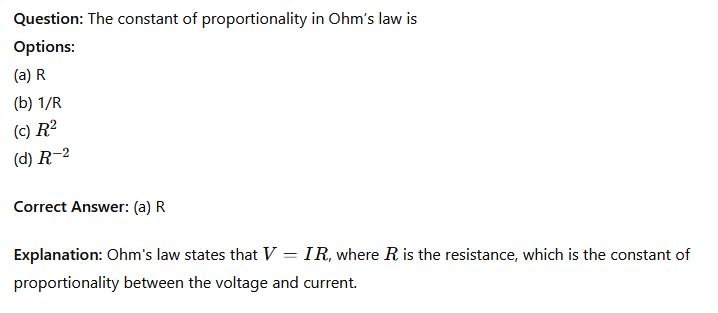
Phy121 past questions and answers 31
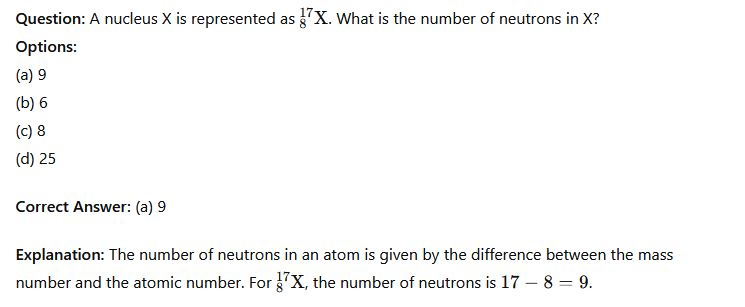
Phy121 past questions and answers 32
Question: The resistor with high resistance connected in series with a galvanometer to convert it to a voltmeter is called
Options:
(a) Multiplier
(b) Shunt
(c) Potentiometer
(d) Meter bridge
Correct Answer: (a) Multiplier
Explanation: A multiplier is a high resistance connected in series with a galvanometer to convert it into a voltmeter, allowing it to measure higher voltages without being damaged.
Phy121 past questions and answers 33
Question: In Kirchhoff’s law, the current that leaves a junction is assigned a _________ sign.
Options:
(a) Positive
(b) Negative
(c) Neutral
(d) Reverse
Correct Answer: (a) Positive
Explanation: According to Kirchhoff’s current law (KCL), the current entering a junction is considered positive, and the current leaving the junction is also considered positive, as they sum to zero.
Phy121 past questions and answers 34
Question: When capacitors are connected in series, the applied voltage _________ the sum of individual voltages.
Options:
(a) Reduces
(b) Increases
(c) Equals
(d) Separates
Correct Answer: (c) Equals
Explanation: In a series connection of capacitors, the total applied voltage is equal to the sum of the voltages across each capacitor.
Phy121 past questions and answers 35
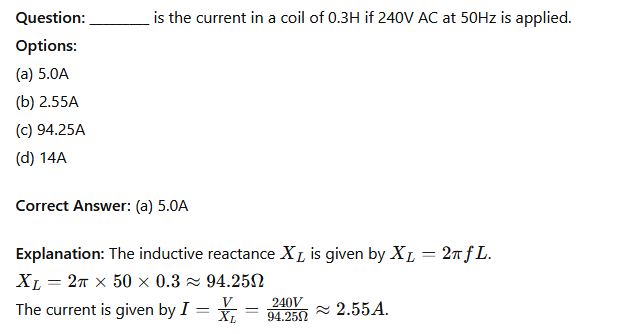
Phy121 past questions and answers 36
Question: Capacitors connected in series are the exact opposite of resistors connected in ______________.
Options:
(a) Parallel
(b) Totally
(c) Partially
(d) Series
Correct Answer: (a) Parallel
Explanation: The equivalent capacitance for capacitors in series is calculated similarly to resistors in parallel. The inverse of the total capacitance is the sum of the inverses of the individual capacitances.
Phy121 past questions and answers 37
Question: Charging by induction is
Options:
(a) Touching two positive charges
(b) Touching two negative charges
(c) Charging a body without touching it
(d) Touching two irons
Correct Answer: (c) Charging a body without touching it
Explanation: Charging by induction involves creating a charge in a conductor by bringing a charged object near it without making contact. The nearby charge causes a redistribution of charges within the conductor.
Phy121 past questions and answers 38
Question: From Kirchhoff’s law, the sum of the currents at a junction is equal to
Options:
(a) Zero
(b) 1
(c) 2
(d) All of the above
Correct Answer: (a) Zero
Explanation: Kirchhoff’s current law (KCL) states that the total current entering a junction equals the total current leaving the junction, implying that their sum is zero.
Phy121 past questions and answers 39
Question: One of these is an application of Lenz’s law
Options:
(a) Transformer
(b) Resistor
(c) Capacitor
(d) Battery
Correct Answer: (a) Transformer
Explanation: Lenz’s law is applied in transformers to determine the direction of the induced EMF, ensuring energy conservation by opposing the change in magnetic flux that caused it.
Phy121 past questions and answers 40
Question: What is the difference between mass and weight?
Options:
(a) Mass and weight are the same
(b) Weight is the force exerted on a body by gravity, and mass is the amount of matter in the body
(c) Mass is the force exerted on a body by gravity, and weight is the amount of matter in the body
(d) Mass and weight are related by acceleration
Correct Answer: (b) Weight is the force exerted on a body by gravity, and mass is the amount of matter in the body
Explanation: Mass is a measure of the amount of matter in a body and is a scalar quantity, while weight is the force exerted on a body by gravity and is a vector quantity.
Phy121 past questions and answers 41
Question: According to Einstein’s theory of relativity, the speed of light is
Options:
(a) Variable
(b) Infinite
(c) Constant
(d) Dependent on the observer’s speed
Correct Answer: (c) Constant
Explanation: According to Einstein’s theory of relativity, the speed of light in a vacuum is a constant, denoted as ccc, and is the same for all observers regardless of their motion relative to the light source.
Boosting Your Knowledge with Practice Quizzes: Your Path to Success
To get the most out of your study sessions, make quiz practice a regular part of your routine. Set aside a few minutes each day to tackle a quiz, and watch as your understanding deepens and your scores soar.
Remember, every quiz you take is a step closer to achieving your goals. Whether you’re preparing for an exam, enhancing your knowledge, or simply testing your understanding, practice quizzes are your gateway to success. So, take the leap—start quizzing today, and empower yourself to reach new heights!


